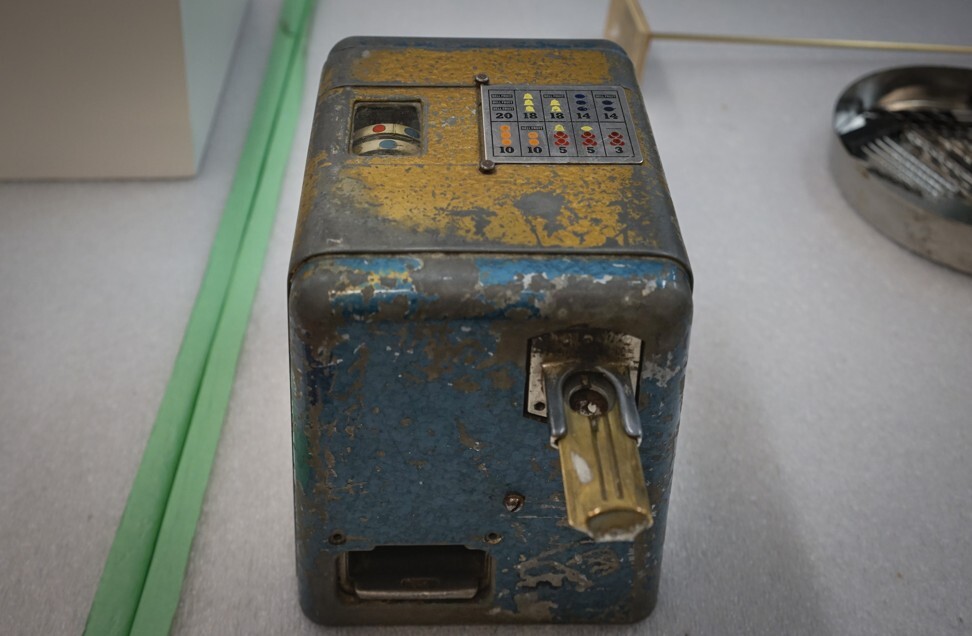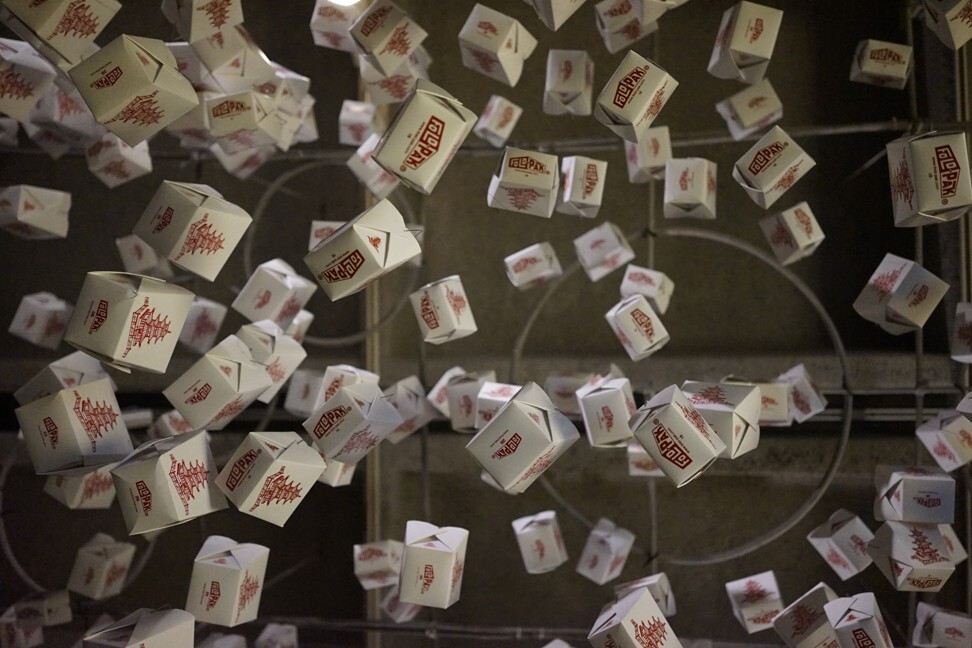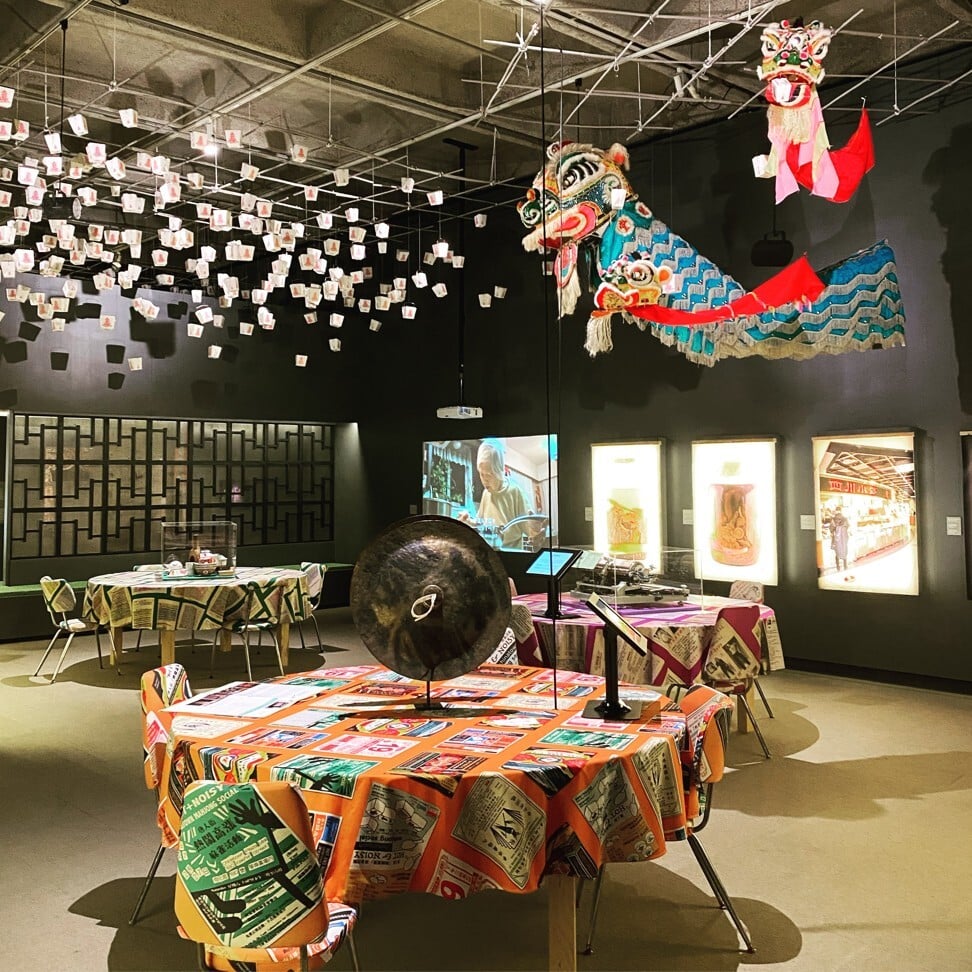
Tales of Chinese-Canadians in Vancouver through the decades brought to life, from their struggles to cultural impact
- The Museum of Vancouver’s latest exhibition focuses on the history of Chinese-Canadians in British Columbia, its first such show in 20 years
- Items on display include slot machines from illegal gambling dens, old restaurant menus and reminders of the country’s head tax on Chinese immigrants
Three mini slot machines used in an illegal gambling den in the 1940s are among the many objects on display as part of a new exhibition at the Museum of Vancouver focusing on the history of the city’s Chinese-Canadians.
The slot machines are owned by Gary Eng, 65, whose father Joey was a professional boxer before later running a gambling den for about 20 years from the 1940s. They are tiny, about six by eight inches (15cm by 20cm), with reels that turn automatically rather than by the pull of a lever.
“It looks more like a safe than a slot machine,” Eng says with a chuckle. “There were only nickels and dimes at the time. I had to drill one of them to open it because there were coins still in there and I couldn’t find the key.
“We have three left; they used to have a hundred of them,” he says, adding that his father probably sold most of the slot machines, keeping three for old times’ sake.

Catherine Clement, an unofficial historian of Vancouver’s Chinese-Canadian community, says gambling was kept quiet in the city back then. “We’ve often talked about the gambling dens that existed in Chinatown, but nobody alive has ever seen them,” she says. “They were usually hidden away in the middle of a building.”
Titled “A Seat at the Table”, the Museum of Vancouver exhibition, which runs until January 2022, explores Chinese immigration over the decades to the west coast city and the wider province of British Columbia.
A mother’s fight for justice: the killing of Vincent Chin
Chinese immigrants seeking a better life have been arriving in Vancouver for more than 170 years. Arrivals in the mid-1800s, generally from southern China, would leave their villages to travel by ship across the Pacific, looking for work building the Canadian Pacific Railway or trying their luck mining for gold.
More recent waves of immigrants in the 1950s and 1980s brought new ideas, culture and food from Hong Kong, Taiwan and mainland China, enriching Vancouver’s vibrant and multicultural scene, and inspiring the museum’s exhibition.
“It’s not just a story about Vancouver’s Chinese-Canadians. It’s really trying to reach out to other Chinese-Canadian communities in the province,” explains Denise Fong, a co-curator of the exhibition.

Exhibits in the show – the institution’s first exhibition focused on the Chinese community in two decades – can be viewed at the municipal museum and at a converted shop space in Vancouver’s Chinatown.
“[Food] also speaks to the different immigrant experiences in terms of when families come to Canada. A lot of the time they start running a restaurant and usually a few relatives will partner together. There are so many parallels with the stories we hear [about] the early waves of Chinese-Canadians after the [railway] was constructed. They often settled in different locations in small towns in Canada, so one of the industries they went into was starting restaurant businesses. There are also laundries and groceries.”

While many of the exhibits are nostalgic, others are a reminder of more significant moments in the Chinese community’s history, including political activism – in the name of food.
In 1968, the City of Vancouver introduced a by-law stating that perishable meats had to be kept at above 60 degrees Celsius (140 degrees Fahrenheit) or below 4 degrees Celsius (39 degrees Fahrenheit). That affected Chinese-Canadians who wanted to sell fresh meat, who responded by launching a campaign to ensure the availability of succulent Cantonese barbecue meat, or char siu.
“It caused a huge reaction from the Chinese community because they wanted fresh meat, not overly dried and overcooked,” Fong explains.

Enforcement of the by-law led to the closure of five Chinatown meat shops, while two other barbecued meat shops shuttered in solidarity. What ensued was a 10-year legal battle led by Chinese-Canadian community leaders, merchants and activists.
A huge protest was organised, Fong says. “A bunch of businessmen and politicians actually travelled across Canada, went to Ottawa, and went to meet the members of parliament there to present their case. They even brought barbecued meats with them to show them that it was delicious and not poisonous.”
Eventually the by-law was revised, marking a significant victory for the community.

The exhibition also displays the motorcycle helmet and gloves worn by Vancouver-born Gim Wong, a former gunner and pilot officer in the Royal Canadian Air Force who travelled across Canada in 2005 aged 82 to raise awareness of the inequity of the long-defunct head tax his father had been forced to pay when he arrived in the country all those years ago.
In 1885, in a bid to restrict migrants from China entering the country, the Canadian government passed the Chinese Immigration Act. All Chinese people had to pay a tax that started at C$50 and over the years increased to as much as C$500. At the time, Chinese men building the Canadian Pacific Railway earned the equivalent of C$1 a day. Wong’s father had to pay the head tax in 1906, and it was levied on his mother in 1921.
Wong and his son Jeff drove across the country with the ultimate goal of meeting with then prime minister Paul Martin to discuss redress for the former head tax, which was abolished in 1923.
“Nobody wanted him to go,” Jeff Wong says. “He was talking about it for years and years. He was already over 80. He had trouble driving around the block or riding his motorcycle around the block let alone riding across Canada.”

They started in Victoria on June 1, intending to reach Ottawa 4,300km (2,670 miles) away by July 1, Canada Day. Jeff Wong took turns with his father, switching between driving the motorcycle and a van where they slept and stored supplies. However, it quickly became evident the elder Wong could not ride very far and they drove the van the rest of the way.
“It was amazing. Everywhere we stopped people came up and looked at us – who were these strange people – and then inevitably my dad started talking about the head tax with them,” Jeff Wong recalls. “No matter who we talked to, we were able to sway so many people, one person at a time, to see it our way, and what we were complaining about. We did it because we love our country.”
The following year, newly elected prime minister Stephen Harper apologised for the head tax; living Canadians who had paid it, or the living spouses of those who had died, were paid compensation.

The lives of many Chinese-Canadians were hard. Fong collected video interviews of community members of various ages and backgrounds for the exhibition, and found some of the stories tragic.
“We interviewed a popo [grandmother] from Chinatown and she talked about growing up in post-war Hong Kong,” Fong says. “I grew up listening to my grandparents and parents talk about how tough life was in the ’30s and ’40s, and that they didn’t have enough food to eat and everyone was poor. But this popo said when she was a little girl, she had to pick up breadcrumbs and toast crusts [off the streets]. There were flies everywhere, but she picked it up and ate the food. And she would earn a little money by helping to clean up bricks so they could be repurposed for other construction projects. She talked about how hard it was.
“She was an orphan, she was illiterate, but she was so humble. At certain moments she would cry because she would remember how tough it was growing up. I didn’t expect to hear these stories, but for me it’s interesting to learn what it was like for people who grew up in Hong Kong in that era.”

